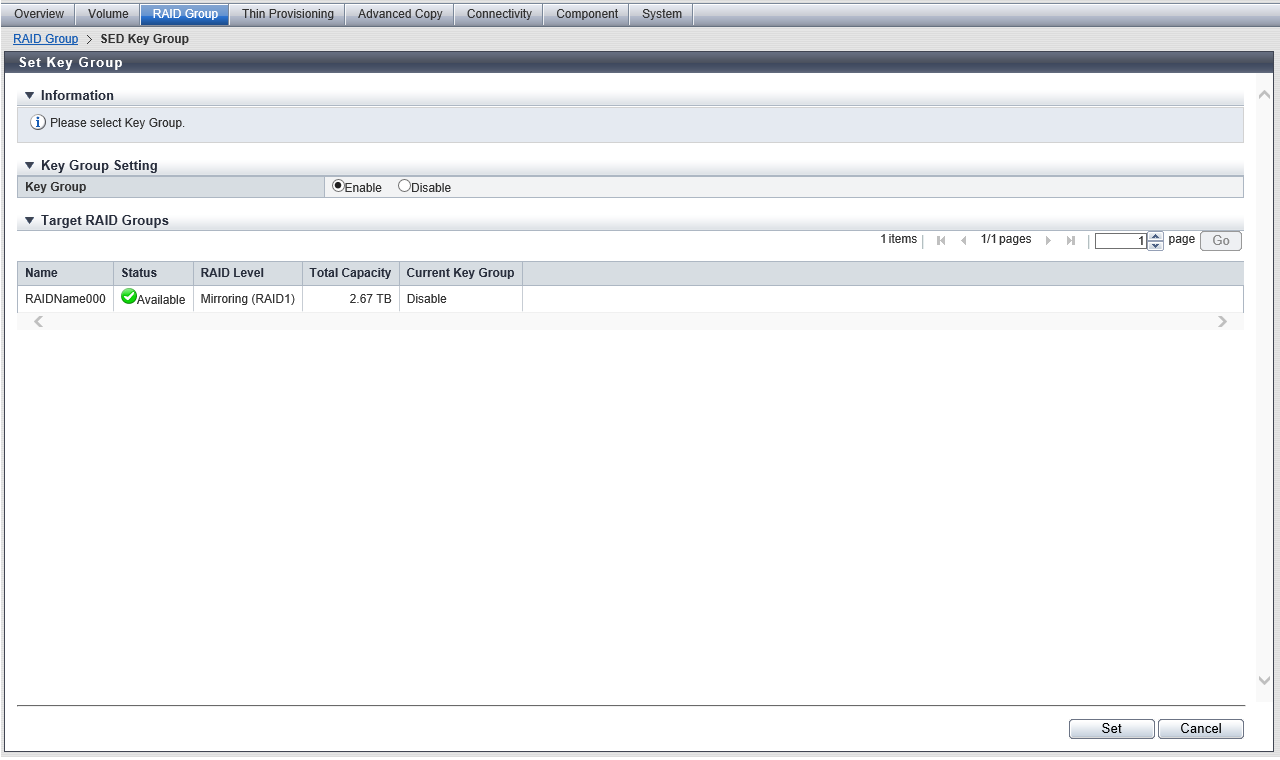Set Key Group (RAID Group)
Overview
This function adds or deletes RAID groups that are configured by SEDs in the key group.
RAID groups in the key group are managed by the SED authentication key that is obtained from the key server. One key group can be created in the storage system.
If a RAID group is not registered in the key group, the RAID group is managed by the common key.
- When registering RAID groups in the key group, perform the following settings in advance.
Create a key group.
Allocate the master server or the slave server to the key group.
Set the key for the key group and confirm that the key status is "Normal".
RAID groups with a status other than "Available" cannot be added to the key group.
Information on the RAID groups that are configured by SEDs and registration status to the key group can be checked in the [SED Key Group] screen. Refer to the [SED Key Group] function for details.
Use the [Key Group] screen to check the SED authentication key information and the SSL/KMIP certificate information that is used for the key group. Refer to the [Key Group] function for details.
Even when volumes that belong to the key management target RAID group are being used, RAID groups can be added to or deleted from the key group.
User Privileges
Availability of Executions in the Default Role
| Default role | Availability of executions |
|---|---|
| Monitor | |
| Admin | |
| StorageAdmin | |
| AccountAdmin | |
| SecurityAdmin | |
| Maintainer |
Refer to "User Roles and Policies" for details on the policies and roles.
Settings
Key Group Setting
| Item | Description | Setting values |
|---|---|---|
Key Group |
To add RAID groups to the key group, select "Enable". To delete RAID groups from the key group, select "Disable". If multiple RAID groups are selected when starting this function, all the selected RAID groups can be enabled or disabled in a single process. |
Enable Disable |
Display Contents
In this screen, detailed information of the selected RAID group is displayed.

Target RAID Groups
| Item | Description |
|---|---|
|
Name |
The RAID group name is displayed. |
|
Status |
The RAID group status is displayed. Refer to "RAID Group Status" for details. Caution
|
|
RAID Level |
The RAID level is displayed. High Performance (RAID1+0) High Capacity (RAID5) High Reliability (RAID6) High Reliability (RAID6-FR) Reliability (RAID5+0) Mirroring (RAID1) Striping (RAID0) |
|
Total Capacity |
The total capacity of the RAID groups is displayed. |
|
Current Key Group |
The set state of the key group for the RAID groups is displayed.
|
Operating Procedures
Select which RAID group to add to or delete from the key group (multiple selections can be made), and click [Set Key Group] in [Action].
CautionSettings for the selected RAID groups are applied in a single process. To add or delete multiple RAID groups, only select the RAID groups that are to be added or deleted (do not select all of the RAID groups).
Select the key group set state, and click the [Set] button.
→ A confirmation screen appears.
Caution- An error screen appears in the following conditions:
If the status of the key in the key group is not "Normal", "Expiration", or "Modifying"
If "Enable" is selected but no key group has been created
If no master or slave server is applied to the key group when "Enable" is selected
- An error screen appears in the following conditions:
Click the [OK] button.
→ Key group setting starts.
Click the [Done] button to return to the [SED Key Group] screen.



